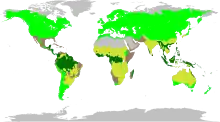豆科
豆科(學名:,替換名:、[6])又名蝶形花科、蘇木科、含羞草科,屬於真雙子葉植物豆目,约有800屬19,325種[7]。為被子植物中相當龐大的一科,占了已知開花植物物種的7%[8][9]。部分物種在經濟上具有重要地位,該科成員形態上包含喬木、灌木,也有多年生或一年生草本植物。該科成員最顯著的特徵是會結豆莢。成員具複葉及托葉。該科成員分布廣泛,為目前已知陸生植物中第三大科,僅次於蘭科及菊科。目前該科已知有765屬,約19,500餘種[4]。其中最大的五屬分別為黃芪屬(Astragalus,逾3,000種)、相思樹屬(Acacia,逾1000種)、木藍属(Indigofera,約700種)、豬屎豆屬(Crotalaria,約700種)、含羞草屬(Mimosa,約500種),這五大屬占了該科物種的四分之一。豆科也是非洲及美洲熱帶雨林和沙漠氣候中,最常見的科別[10][11][12][13]。系統分類學分析認為該科最接近同屬於豆目的遠志科、海人樹科,以及皂皮樹科[14]。中國大陸有172屬,1485種,13亞種,153變種,16變型。臺灣豆科自生及歸化的有79屬246種。
| 豆科 | |
|---|---|
 | |
| 山葛 Pueraria montana | |
| 科学分类 | |
| 界: | 植物界 Plantae |
| 演化支: | Tracheophyta |
| 演化支: | 被子植物 Angiosperms |
| 演化支: | 真双子叶植物 Eudicots |
| 演化支: | 蔷薇类植物 Rosids |
| 目: | 豆目 Fabales |
| 科: | 豆科 Fabaceae Lindl., 1836[2] Leguminosae Juss., 1789 nom. alt. Papilionaceae Giseke, 1792 nom. alt.[3] |
| 模式属 | |
| 蠶豆屬 Faba Mill., 1754(=Vicia L., 1753) | |
| 亞科[4] | |
| |
| 多样性 | |
| 730屬,19,400種 | |
 | |
| 豆科成員分布圖,主要分布於四類生物群系之中:熱帶雨林、溫帶、草原,以及沙地。[5] | |
| 異名 | |
人類利用豆科植物已經有數千年的歷史,且與人類演化具有密切關聯[15]。豆科的作物包含大豆(Glycine max)、菜豆(Phaseolus )、豌豆(Pisum sativum)等等。
語源
豆科的學名「Fabaceae」來自其模式屬蠶豆屬(Vicia)(模式种救荒野豌豆 Vicia sativa L.)的异名「Faba」(模式種蠶豆 Vicia faba L.)。「Faba」於源自拉丁文,意指「豆」。「Leguminosae」是該科更早的學名,但并未以模式属的名字来命名,目前被視作仍然有效的保留名[6]。
分類
描述

豆科成員形態多樣,從喬木(如樹王木)到一年生草本植物皆有,其中最大宗者為多年生草本植物。花序多樣,花朵有一短花托筒及單一雌蕊,雌蕊柄短小。在受精後才會結果。
豆科與其它科區分的特點是其果實為本科獨有的莢果,由一心皮發育而成,成熟時果皮沿背縫線和腹縫線開裂。
莢果通常由2片果瓣组成,1室,種子生在腹縫線上。莢果的形狀、大小及莢瓣質地變化很大。如草木犀属,直徑只有3-4毫米,而生长在热带中的鴨腱藤,木質莢果可長達1公尺。有些有翅,如老虎刺屬的果頂端有一長圓形薄翅;紫檀莢果周圍被一圈闊翅所繞;盾柱木屬和黄檀屬莢果都具有翅。鱼鳔豆的膜質莢瓣,充氣呈泡狀,借風力傳播;猪腰豆的木質莢瓣厚達2公分以上。苜蓿屬和猴耳環屬的一些莢果呈螺旋狀盤捲。阿勃勒的莢果像一根圓柱形的棒。相思子的莢果裡面藏有半红半黑、鮮豔的種子,種皮堅硬有光澤。
生態
豆科為蟲媒,主要為蜜蜂傳粉,少數靠螞蟻、蛾類或甲蟲等傳粉。含羞草亞科和蘇木亞科的一些種類在葉柄、葉軸上帶有花外蜜腺以吸引螞蟻;金合歡屬有些種類莖上有大、中空的刺,供螞蟻停留;決明屬植物有頂孔開裂的基著花葯,適應蜜蜂搖動花药取花粉;蘇木屬植物花絲基部被毛,遮蓋雌蕊和花托口部,避免自花授粉。
系統分類學
| ||||||||||||||||||||||
豆科各亚科关系如下:
| 豆科 Fabaceae |
| ||||||||||||||||||||||||||||||
參見
参考文献
- Wojciechowski, M. F.; Lavin, M.; Sanderson, M. J. . American Journal of Botany. 2004, 91 (11): 1846–62. PMID 21652332. doi:10.3732/ajb.91.11.1846.
- Angiosperm Phylogeny Group. (PDF). Botanical Journal of the Linnean Society. 2009, 161 (2): 105–121 [4 February 2014]. doi:10.1111/j.1095-8339.2009.00996.x. (原始内容存档于2017-05-25).
- Watson L.; Dallwitz, M. J. . 2007-06-01 [9 February 2008]. (原始内容存档于2008-02-15).
- Legume Phylogeny Working Group 2017. A new subfamily classification of the Leguminosae based on a taxonomically comprehensive phylogeny. Taxon 66(1): 44–77. doi:10.12705/661.3
- Schrire, B. D.; Lewis, G. P.; Lavin, M. . Lewis, G; Schrire, G.; Mackinder, B.; Lock, M. (编). . Kew, England: Royal Botanic Gardens. 2005: 21–54 [2021-01-22]. ISBN 978-1-900347-80-8. (原始内容存档于2014-02-02).
- International Code of Nomenclature for algae, fungi, and plants. (页面存档备份,存于) Article 18.5 states: "The following names, of long usage, are treated as validly published: ....Leguminosae (nom. alt.: Fabaceae; type: Faba Mill. [= Vicia L.]); ... When the Papilionaceae are regarded as a family distinct from the remainder of the Leguminosae, the name Papilionaceae is conserved against Leguminosae." English pronunciations are as follows: 英語 /fəˈbeɪsi, -siˌaɪ, -siˌeɪ, -siˌi/; 英語 /ləˌɡjuːməˈnoʊsi/; and 英語 /pəˌpɪlioʊˈneɪsiˌi/.
- ed. by Gwilym Lewis. 1st ed. Richmond: Royal Botanic Gardens, Kew. 2005: 1–577. ISBN 978-1900347808.
- Judd, W. S., Campbell, C. S. Kellogg, E. A. Stevens, P.F. Donoghue, M. J. (2002), Plant systematics: a phylogenetic approach, Sinauer Axxoc, 287-292. ISBN 0-87893-403-0.
- Magallón, S. A., and Sanderson, M. J.; Sanderson. (PDF). Evolution. 2001, 55 (9): 1762–1780 [2018-03-10]. PMID 11681732. doi:10.1111/j.0014-3820.2001.tb00826.x. (原始内容 (PDF)存档于2013-10-19).
- Burnham, R. J.; Johnson, K. R. . Philosophical Transactions of the Royal Society B: Biological Sciences. 2004, 359 (1450): 1595–1610. PMC 1693437
 . PMID 15519975. doi:10.1098/rstb.2004.1531.
. PMID 15519975. doi:10.1098/rstb.2004.1531. - Doyle, J. J., J. A. Chappill, C.D. Bailey, & T. Kajita. 2000. Towards a comprehensive phylogeny of legumes: evidence from rbcL sequences and non-molecular data. pp. 1 -20 in Advances in legume systematics, part 9, (P. S. Herendeen and A. Bruneau, eds.). Royal Botanic Gardens, Kew, UK.
- Kajita, T.; Ohashi, H.; Tateishi, Y.; Bailey, C. D.; Doyle, J. J. . Systematic Botany. 2001, 26 (q): 515–536 [2018-03-10]. JSTOR 3093979. (原始内容存档于2017-05-17).
- Wojciechowski, M. F., M. Lavin and M. J. Sanderson; Lavin; Sanderson. . American Journal of Botany. 2004, 91 (11): 1846–1862 [2018-03-10]. PMID 21652332. doi:10.3732/ajb.91.11.1846. (原始内容存档于2010-06-21).
- Angiosperm Phylogeny Group [APG]. (PDF). Botanical Journal of the Linnean Society. 2003, 141: 399–436 [2018-03-10]. doi:10.1046/j.1095-8339.2003.t01-1-00158.x. (原始内容 (PDF)存档于2018-03-10).
- Burkart, A. Leguminosas. In: Dimitri, M. 1987. Enciclopedia Argentina de Agricultura y Jardinería. Tomo I. Descripción de plantas cultivadas. Editorial ACME S.A.C.I., Buenos Aires. pages: 467-538.
- Angiosperm Phylogeny Group (2009). An update of the Angiosperm Phylogeny Group classification for the orders and families of flowering plants: APG III. Botanical Journal of the Linnean Society 161(2): 105-121.(英文)
- Fabales. In Stevens, P. F. (2001 onwards). Angiosperm Phylogeny Website. Version 9, June 2008 [and more or less continuously updated since].
外部連結
- Leguminosae(页面存档备份,存于) at The Plant List(页面存档备份,存于)
- Leguminosae(页面存档备份,存于) at The Families of Flowering Plants (DELTA)(页面存档备份,存于)
- Fabaceae(页面存档备份,存于) at the Encyclopedia of Life(页面存档备份,存于)
- Fabaceae(页面存档备份,存于) at the Angiosperm Phylogeny Website(页面存档备份,存于)
- Fabaceae(页面存档备份,存于) at the Tree of Life Web Project(页面存档备份,存于)
- Fabaceae(页面存档备份,存于) at the online Flora of China(页面存档备份,存于)
- Fabaceae(页面存档备份,存于) at the online Guide to the Flora of Mongolia(页面存档备份,存于)
- Fabaceae(页面存档备份,存于) at the online Flora of Zimbabwe(页面存档备份,存于)
- Fabaceae at the online Flora of Western Australia
- Fabaceae(页面存档备份,存于) at the online Flora of New ZealandArchive-It的存檔,存档日期2017-05-25
- Leguminosaeat the (页面存档备份,存于)
- Fabaceae(页面存档备份,存于) at Flowers in Israel(页面存档备份,存于)
- 豆科Fabaceae(页面存档备份,存于) 藥用植物圖像數據庫 (香港浸會大學中醫藥學院) (中文)(英文)
- 黃豆苷元 Daidzein(页面存档备份,存于) 中草藥化學圖像數據庫 (香港浸會大學中醫藥學院) (中文)(英文)